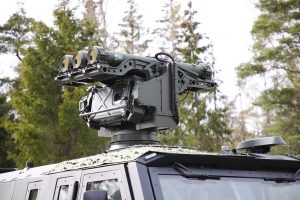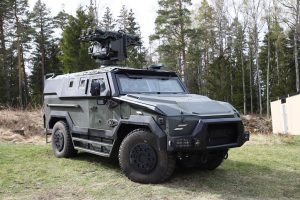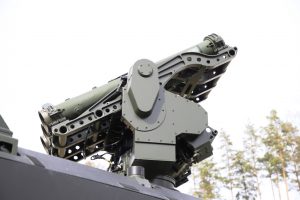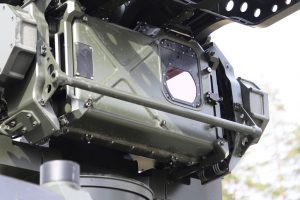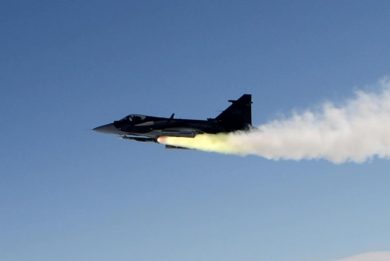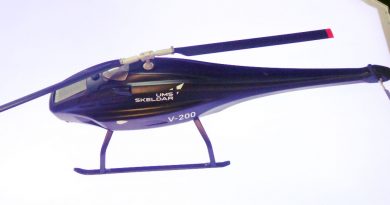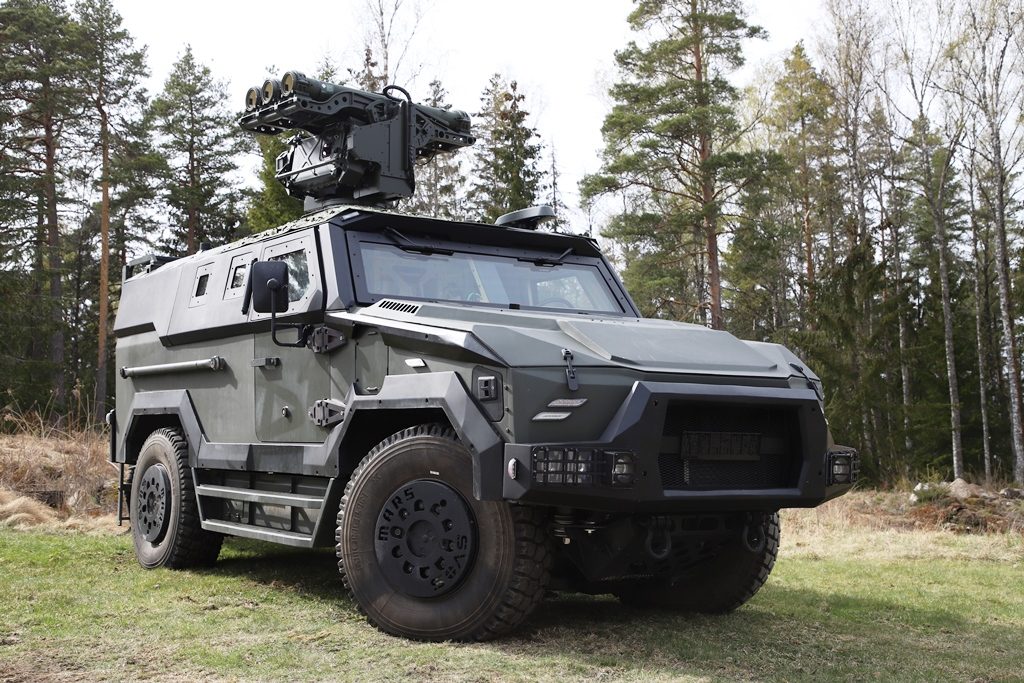
Saab details its Mobile Short-Range Air Defence (MSHORAD) solution
Announced on March 30th this year, the new Saab Mobile Short Range Air Defence System (MSHORAD) was exhibited in Karlskoga on Day 2 of the Ground Combat Demonstration 2022, bringing on the stage another Business Unit part of the Dynamics Business Area.
The decision to develop a light mobile and protected ground-based air defence system comes from various considerations, the first being the evolved threat that warfighters are meeting on the field, loitering munitions and UAS adding to the more conventional rotary and fixed wing aircraft. “We also considered that most GBAD inventories are ageing, that higher mobility is needed, and that a system capable to operate both in the urban scenario as well as in open terrain was necessary,” Mats-Olof Rydberg. Vice President Marketing and Sales, BU Missile Systems at Saab Bofors Dynamics, said. Another key driver is cost: “Although events in Ukraine are pushing towards a considerable increase in defence budgets, we must also keep in mind that armed forces demands will also increase, therefore we must propose cost-effective solutions,” he added.
Saab Dynamics also aimed at exploiting current users inventories, allowing customers base to use on the new systems missiles of different standards within the RBS 70 short-range laser beam-riding air defence missile family; over 20 nations are using the Saab missile, five of which in its latest iteration, the RBS 70 NG, the last nation to sign a contract for the latter version being Argentina. The MSHORAD can therefore be fitted with older versions of the missile. Developed since the late 1970s, the RBS 70 has become a family of missiles, and the RBS 70 NG represents the latest iteration. “It looks similar to the old version, but it is a completely new missile, the good point being that it is backward compatible,” Mr. Rydberg points out. The RBS 70 NG currently in production has an effective range of 9 km, and is capable to hit targets up to 5,000 meters height, the missile reaching a maximum velocity of Mach 2.
Based on the previously described assumptions, a couple of years ago the Saab management decided to invest in a new highly mobile system, the aim being to develop a solution capable to be integrated almost on any vehicle. The MSHORAD system is based on different elements, the first being the RBS 70 NG missile installed on the Mobile Firing Unit (MFU) together with the Command and Control (C2) software that connects the MFU to the other main element of the system, the Mobile Radar Unit (MRU) based on the company Giraffe 1X 3D multi-mission radar.
All those elements come from inside Saab, the only part of the MSHORAD that the Swedish group is not providing being the mobility platform.
The one selected for the developmental work is the MARS 4×4 S-330 designed and manufactured by SVOS in the Czech Republic. A 12.5-14 tonnes GVW vehicle fitted with adjustable suspensions and a STANAG Level 2 armour, it features a wide protected cabin and is used as the platform for both the MRU and the MFU. The choice of the Czech vehicle might imply a potential interest in that country, however there is no exclusivity and Saab is ready to integrate its MSHORAD on vehicles of similar size or bigger, wheeled or tracked, the weight of the turret, which is based on the Trackfire platform used in the company RCWS, reaching a maximum of 400 kg armed with the three missiles.
As said the MRU is fitted with the Giraffe 1X X-band 3D radar which is based on an AESA antenna; with a weight of less than 300 kg and a consumption of 2.3 kW, it has an elevation coverage of over 70° and a rotation rate of 60 rpm. Its instrumented range is 75 km, data provided by Saab showing detection ranges of 30 km and up to 10,000 meters altitude against fighters, 25 km and 8,000 meters against smaller aircraft, and 13 km and 4,000 meters against small UAS, the Giraffe 1X being capable to follow over 100 air tracks at the same time. “A single MRU can be connected to the wider air defence network, but can also work in stand-alone mode, and can be connected up to 12 MFUs,” Paul Wooldridge,Product Director for MSHORAD and Mobile firing unit, BU Missile Systems at Saab Dynamics AB at Saab, told the audience. Should a customer consider using it mostly in a stand-alone mode, Saab is ready to integrate an IFF in the MRU. Communications are ensured through encrypted or IP radios, a cable solution being also available, the latter allowing passive operations when the system is deployed in pre-planned deployment positions. The MRU is mounted on a double-cabin version of the MARS fitted with a flatbed at the rear that hosts the radar.
The MFU is fitted on the full-length cabin version of the SVOS vehicle that provides a lot of internal space allowing to carry, in the current standard configuration, the three-man crew with all its equipment, as well as four spare missiles and the MANPAD stand. On top of the vehicle we find the Trackfire turret on which Saab Dynamics Missiles integrated the three-missile launcher designed for the remotely controlled version, as well as the new generation Common Sight Module. This includes a high-resolution thermal imaging with day and night capabilities, and is fitted with advanced cueing for improved reaction times and target acquisition, with an auto-tracker that assists the operator during the engagement increasing hit probability, with improved aiming aids to further improve system performance, both for manual and auto-tracker engagements, and with built-in video recording for after-action review.
When the vehicle is on the move the sight is protected by a mirror, but it can be used to carry out surveillance, and if a threat is detected fire-on-the-move would not be impossible, however EDR On-Line understood that the best procedure would be to track the target, bring the vehicle to a halt, and immediately fire a missile, the tracking system following it while the operator finetunes the aiming.
The sight can be easily removed from the vehicle thanks to a quick-release mechanism; the pedestal is hosted in the rear of the vehicle together with the power supply, so the crew can take all those elements together with at least one missile, generating a MANPAD configuration that, when i.e. deployed in urban areas, can be installed on a rooftop. This gives the system a considerable flexibility of use, which is further enhanced by the missile warhead itself; having been designed to cope with armoured helicopters, the RBS 70 features a shaped charge/fragmentation warhead that ensures good penetration against ballistic protections, hence it can also be used effectively against armoured personnel carriers.
Inside the vehicle we find the driver at the front-left, with the missile operator at his right. All control systems and computers being at the centre. The C2 operator station is behind the driver, followed by the MANPAD stand, while on the right we find spare missiles; theoretically the vehicle could host over a dozen spare rounds, however Saab estimates at six the maximum number, considering that requirements usually include soldiers equipment for a three-day mission. To bring the new missiles to rooftop level a rear ramp was designed that allows installing the missiles at the end of the ramp and when closing it these are elevated over the roof allowing the operator to easily install each of them, which weighs around 25 kg, on the turret, estimated reloading time of the three missiles being around 60 seconds. This system was not yet visible on the prototype exhibited at Karlskoga, the inside layout being also still to be finalised.
The MSHORAD mission systems have a mean power consumption of around 600 W, and can run on batteries for 30-60 minutes, an external power supply, i.e. an auxiliary power unit installed outside the vehicle, ensuring longer operational time with the vehicle engine off.
Saab was awaiting the delivery of the vehicle where the radar will be installed, and is planning a further test in early June. “In mid February we did some system firings in central Sweden deploying the MRU and the MFU, the target being represented by a towed sleeve. The system was fired when the target was at 6 km distance, hitting it at over 5 km at a height of around 500 meters,” Paul Wooldridge explained, adding that over 10 firings were carried out. The trials allowed to verify the complete engagement, with the radar detecting and then acquiring the target, the C2 system assigning it to an MFU, which received the data, the firing commander assigning the target to the missile operator, the weapon turret on top of the vehicle tracking it, then the operator locked on the target and fired, guiding the missile on the target and destroying it. The sleeve was 8 meters long with a 0.6 meters diameter, was flown as said at 500 meters height at a speed of around 90 m/s (175 knots or 342 km/h), and the missile overflew the sleeve by 0.5 meters, detonating thanks to the proximity fuse. The test was repeated in different configurations to verify the system behaviour, as the missile itself didn’t needed a validation as it is already fully qualified.
A formal demonstration will take place in late August in Karlskoga. This will comprise the MRU and MFU in their final prototype configuration. Saab also plans to demonstrate how the system can quickly generate a MANPAD. An M113 tracked armoured personnel carrier will be on display, fitted with dummy equipment to show the capability to deploy a mobile training system all inside a vehicle, avoiding the customer to have a classroom trainer, the aim being to show a set of capabilities to potential customers.
According to Saab, deliveries can be expected 24 months after the signature of a firm order.
Photos by P. Valpolini

